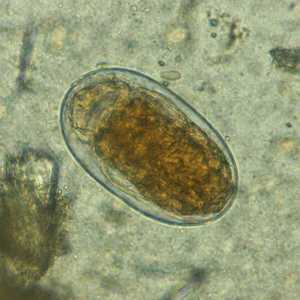
Case #367 - March 2014
A citizen of the Netherlands presented with abdominal discomfort after returning home from a two-month trip to Suriname. During the second month of his trip, he noticed the appearance of blood and mucus in his stool. After he returned home he visited his primary care provider, where stool specimens were collected for routine ova-and-parasite examination. Figure A shows what was observed in low numbers in a Ridley-Allen concentration of the stool. The objects measured on average 125 micrometers long by 62 micrometers wide. What is your diagnosis? Based on what criteria?

Figure A
Case Answer
The object shown in the image was a mite egg and a diagnosis of No Parasites Found (NPF) was made. Although superficially similar to the eggs of hookworm and Trichostrongylus, mite eggs are typically much larger. Also, as in this specimen, budding appendages can often be seen.
More on: artifacts
This case and image were kindly provided by the Laboratory for Medical Microbiology and Public Health Twente Achterhoek, Enschede, Netherlands.
Images presented in the monthly case studies are from specimens submitted for diagnosis or archiving. On rare occasions, clinical histories given may be partly fictitious.
DPDx is an education resource designed for health professionals and laboratory scientists. For an overview including prevention and control visit www.cdc.gov/parasites/.
- Page last reviewed: August 24, 2016
- Page last updated: August 24, 2016
- Content source:
- Global Health – Division of Parasitic Diseases and Malaria
- Notice: Linking to a non-federal site does not constitute an endorsement by HHS, CDC or any of its employees of the sponsors or the information and products presented on the site.
- Maintained By:


 ShareCompartir
ShareCompartir